What is the construction of capital structures begins? Of course, from the foundation. Therefore, the durability of the building and safety of finding in it depends on the proper selection of concrete brand and compliance with all requirements. What types of foundations exist which brands of concrete for foundations are used, by which criteria to select concrete, how to properly prepare a concrete mix and pour the foundation so that it turns out strong and reliable? In the article you will find the answers to all of the listed questions.
Content
Types of foundations
During the construction of private houses, several basic types of foundations that provide capital buildings, durability and safety are used.
Tape
The most common type of foundation, while relatively inexpensive with sufficient strength. To build a ribbon foundation throughout the perimeter and under the bearing walls of the future construction, a trench is digging, the depth of which is calculated depending on the type of structure: the harder it is planned to build a building, the more the depth of the trench, and the concrete brand under the foundation is selected higher class. To enhance the foundation, fittings and boot (building stone) are used.

Columnar
Cheaper than a belt, but also less strong foundation. This species is chosen in the construction of small wooden houses, in which the basement is not planned. The foundation consists of pillars (supports) located at a distance from one and a half to three meters from each other. Supports are installed under the corners of the building and at the intersection of bearing walls. As materials used concrete, boot, brick and, in some cases, wood. The foundations are stacked by the foundation beams, on which the walls of the building are erected. To know exactly what concrete is used for the foundation, you need to calculate the weight of the building and provide for the impact of all external factors.

Pile
Instead of piles, piles from various materials are used in this formation. The greatest loads withstand reinforced concrete piles and steel, so this kind of foundation is more reliable than the column and at the same time it is often cheaper than the tape. When erecting a pile foundation, two methods of installing piles in the ground are used: scoring, when using special equipment, piles are clogged into the soil to the necessary depth, and the fuel, at which the well is drilled with a diameter of up to 40 cm, the vertical fittings are installed in it and is poured with a concrete mixture. Concrete floors are stacked on the piles to build the walls of the structure.
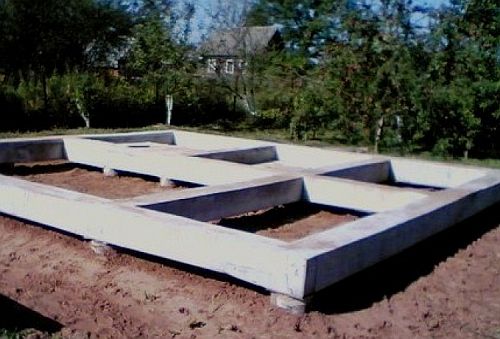
Slab
Such a foundation is asked in difficult cases when there are problems with the soil: landslides are possible, close groundwater occurrence, construction is carried out on a bulk soil and others. The monolithic concrete plate is created on the reinforcement basis under the entire area of \u200b\u200bthe building. When erecting a monolithic plate, a concrete brand is selected for the foundation of the house of the highest class. This foundation is not terrible soil displacement, so it is also called "floating". The slab foundation is withstanding the structure in several floors. With all indisputable benefits, a serious disadvantage of foundation plates is a high cost due to a large consumption of concrete. But to avoid further problems with the state of the foundation and building during construction on a complex soil, it is better not to save on the brand of concrete.

Concrete brands for filling foundation
The main criterion when choosing a brand of concrete for the foundation is strength, that is, the ability to resist the effects of external loads and destructive factors. The classification of concrete is made according to brands or classes indicating the indicators of the durability of axial compression and pressure. The higher the numbers of the class and the brand, the stronger and the harder concrete mixture.
Concretes from M-100 V-7.5 to M-250 B-20 are used for concrete screeds, in road construction, gentlemen and when building foundations for lightweight small buildings.
M-300 B-22.5 and M-350 B-25 concretes are the most used in private construction when erecting various types of foundations, since these brands of concrete are perfect price / quality ratios. If you do not know which brand of concrete is to fill the foundation when conducting construction on the usual soil, then you will not be mistaken by ordering the M-300 or M-350 concrete.
M-400 B-30 and M-450 B-35 concrete are mainly used in the construction of bridges, hydraulic structures, in the foundations of monolithic multi-storey buildings, in the metro station and during the construction of banking storage. These are expensive varieties of concrete mixtures, so they are quite rarely used in private construction. However, when building buildings on a complex soil, it is better to use expensive brands of concrete, so that the savings did not "come out by side later."
The brands of concrete above the M-450 in private construction are not applied due to high costs.
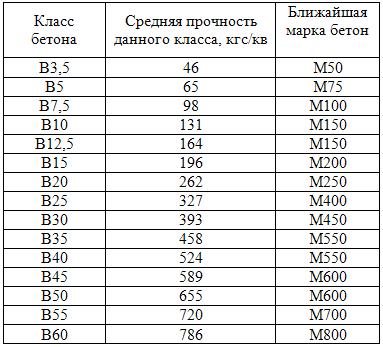
What concrete is needed for foundation
Independent construction of construction work without special knowledge in many cases leads to serious problems, so think a hundred times before you decide on such a responsible step. It is better to invite specialists who accurately calculate what concrete is better to apply for the foundation, on the basis of all available information.
During the construction of a garage, a barn, a gazebo or a small wooden country house without a basement, you can make approximate calculations of the future load on the foundation. Usually for such buildings of a fairly columnar foundation and concrete M-200 or M-250.
The construction of a residential building provides for the conduct of thorough calculations that take into account the following factors:
- the nature of the soil and the level of groundwater occurrence;
- the presence in the future structure of the basement or underground floor;
- the weight of the future structures, the load on the foundation;
- type of foundation;
- Temperature mode and humidity level during the operation of the foundation.
It is necessary to take into account everything, without exception, factors to know exactly how to fill the foundation.


Characteristics of soils
Sand and rock soils are considered comfortable for foundations due to homogeneity, that is, the load on the foundation will be uniform. For light buildings under such soils, concrete M-150 - M-200 is suitable. For buildings from heavy materials - M-300 and M-350 brands.
At clay soils are high buncinity. Clay increases significantly in the amount during the freezing. This occurs unevenly, depending on its saturation with water in various places. That is, the impact on the foundation of the clay soil during the frost will be uneven. In such soils are not asked: "What is the concrete to choose for the foundation?" A concrete from M-350 to M-450 is used.
Load for foundation
The weight of the building depends on the material from which it will be built, respectively:
- Wooden or team-panel house can be built on the foundation M-150 - M-200;
- a house from a profiled timber, from logs, foam blocks, gas-silicate and ceramzite-concrete blocks are built on the foundation from concrete M-250 - M-300 concrete;
- Brick, monolithic and panel buildings require the use of brands from M-350 and higher.
Waterproof Fundament
When making a decision, which concrete is to choose for the foundation, it is necessary to take into account the presence of the basement in the house. If the basement is provided, then such an indicator of a concrete mix, as water resistance, becomes important. At concrete M-350, this figure is two times better than M-250, based on this, draw conclusions. If you still decide to save, then make the foundation waterproof with the help of outer waterproofing or with the help of additives that increase water resistance.
Concrete proportions for foundation
When all calculations are made and decided on the type of foundation of the foundation and how concrete is better to fill the foundation, you need to calculate the amount that is required for its construction and purchase a concrete of factory production or prepare a concrete mix yourself.
Calculation of the amount of concrete mix for various types of foundation
Performed by formulas:
- Ribbon: V \u003d 2ab * (C + D) (Do not forget to take into account and the length of all partitions, and not only the perimeter of the foundation), where A is the width of the foundation, B - the height, C - the length of the structure, D is the width of the internal perimeter of the structure ;
- slab: V \u003d x * C * b, where X is the width of an external perimeter;
- Column: V \u003d (3.14d² / 4) * H, where D is the diameter of the column (if the columns of the round form, if the square, then the formula of the cube volume), H is its height.
The calculated volume is multiplied by 10% - stock for unforeseen circumstances.
Industrial concrete
If the construction of a residential building is underway, a concrete mix is \u200b\u200bbetter to order at the factory. In the industrial production of a concrete mixture of a solution proportion for the foundation is compiled in the laboratory, strictly observed when mixing and checked using special equipment. The size of the ingredients, the percentage of humidity and the presence of impurities, as well as the mixing time strictly correspond to the standards. To the construction site, the concrete mixture is delivered by special transport, in which the necessary plasticity of concrete is preserved.

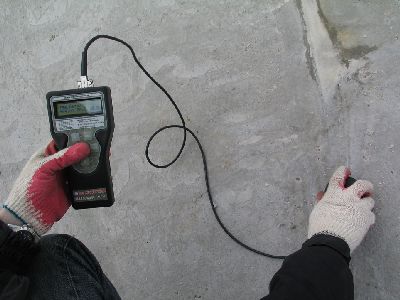
Independent preparation of concrete mix
If you still decided to cook concrete in the field at the construction site, then be very neat when measuring the desired number of ingredients, mix well (ideally, it is better to purchase a concrete mixer, but you can mix and manually shovel on a flat, dry, wooden or metal plate Or in a bath), quickly spend the concrete mix and well tamper it if you cook heavy concrete.

The composition of the concrete mix includes: cement (portland cement), sand, gravel (crushed stone) and water. Sometimes, plasticizers are used to improve the properties of concrete mix and savings. What proportion of concrete for the foundation is considered ideal?
The fact is that proportions depend on the size of the rubble and from the cement brand. The proportion of 1: 3: 5 is usually applied, that is, on 1 part of the cement, 3 pieces of sand and 5 rubble are taken. This formula is suitable for Portland cement 400 to get concrete by properties close to M-200. To obtain concrete M-300, the proportion of the mixture for the foundation will be 1: 2: 4. Water consumption will approximately be 2 times less than cement, but it is necessary to look at the consistency of the mixture and make a solution by the amount of water yourself. Must get a thick and homogeneous mixture. By consistency, concrete is divided into flowable (withstands the load less than 1800 kg / m2) and rigid (more than 1800 kg / m2). Hard concretes must necessarily be tamped, otherwise the required foundation density will not be obtained, which will adversely affect its characteristics.
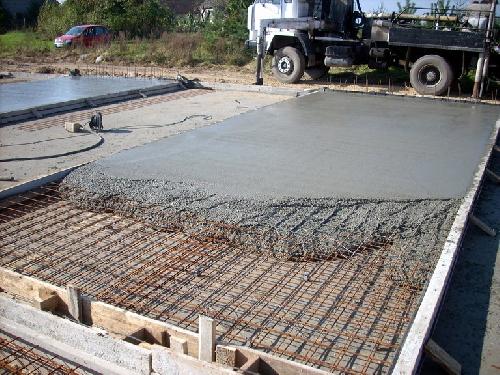
The quality of concrete, first of all depends on the cement brand. Typically, the portland cement of the brand is not below 300, the optimal version 400, if possible, is allowed, then a higher brand is used. It must be remembered than the above cement brand, the faster the finished concrete mixture is hardening, that is, when filling the foundation it is necessary to act very quickly. To save on cement, which fills emptiness between rubble and sand, you need to use rubble as smaller as possible. The sand is used purified from various impurities and clays with particle sizes from 1.3 to 3.5 mm. If the number of impurities in the sand will be more than 5%, it will significantly worsen the quality of concrete.


With the exact and correct compliance with the proportions of concrete preparation for the foundation, the use of the recommended brand of portland cement, the size of the sand particles, the degree of purification of sand and the properly calculated volume required for the foundation of the mixture, concrete will be waterproof, strong and frost-resistant, which is required for the reliability of the structure. Complete frozen concrete lasts about 28 days. After this period, you can begin the construction of the walls of the building.

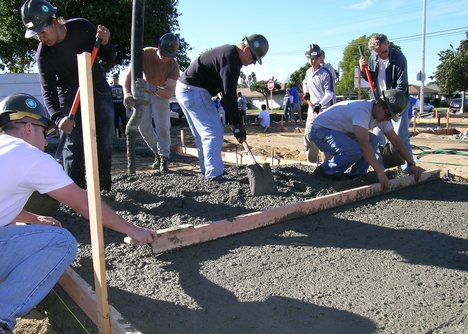


















Mediatory site with sensing content
Hello! Article - Straight guide to action. I decided to dwell on the option of ordering a concrete solution, and not independent preparation, ordered on http://beton-tvs.by/ . Already the foundation flooded.